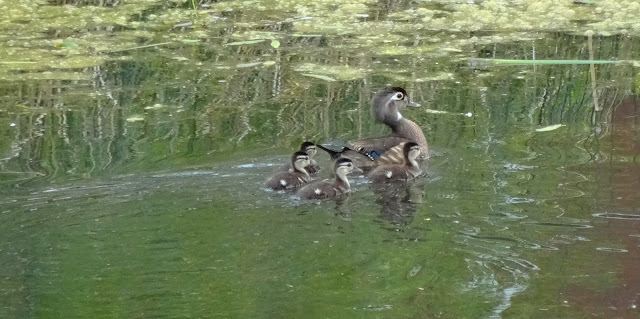7/05/2022
7/28/2021
convivial ducks
This summer has been very scant on rainfall so far. The pond water level is currently low, and there is plenty of algae floating. But the rocks are always good places for sharing the sunshine. Female Mallard and Hooded Merganser have raised their young broods here, and shared the big rock today.
6/12/2021
dragonflies
Two large darner dragonflies hovered on pondweed growing in the water. Each dragonfly is over 3 inches long, and more brilliant blue and green colors than the vegetation nearby. They seemed to be connected (with the male grabbing the female by the head with his rear abdomen appendages) which suggests some stage of mating.
4/30/2021
basking turtles
Many Painted Turtles Chrysemys picta live in the pond. On sunny days they climb out of the water and bask in the sun to warm their blood. In this temperate Spring weather, they spread all their appendages including head and neck out of the shell to get maximum exposure.
10/05/2020
floating pondweed
The floating leaves of Pondweed are fading at the end of summer. And the leaves of the nearby trees fall in the water, drift with the breeze, and catch on the Pondweed. They look golden in the sunlight, brighten the pond, and complement the wildflowers surrounding the water.
Floating Pondweed Potemogeton natans has two kinds of leaves; floating and submerged. The shiny leathery floating leaves are opaque, and support the whole plant which is rooted in the mud below. The submerged leaves are thin, transparent, and move with the water. In summer these plants provide habitats for many tiny aquatic invertebrates. These in turn are used as food by frogs, snakes, turtles, and ducks who feed here. After these plants die, their decomposition by bacteria and fungi provides food in turn for the aquatic invertebrates. The Pondweed survives winter with rhizomes buried in the mud at the bottom.
9/20/2020
leopard frog
Leopard Frogs Lithobates pipiens who live in our pond may travel one or two miles from water in the summer. You might hear them make a long, deep 'snore' noise lasting several seconds ending with a chuck-chuck-chuck. In the fall, Leopard Frogs come back to their pond. We saw this one hopping across the sandy shore. They spend the cold winter in the water, burrowed into the mud, hibernating with their metabolism slowed.
7/02/2020
6/29/2020
high water
This morning, after
7 inches of rain fell overnight, the pond is higher than usual and some of the shoreline around it is under water. The critters are trying to find their favorite places to feed or soak up the sun.
I was watching a turtle crawl slowly up on a small rise among the grasses.
Then a frog croaked, and I noticed him right near the turtle. We've been hearing these Green Frogs
Rana (Aquarana) clamitans
for several weeks. They are usually secretive; this is first time I've seen one here. Do you see him in the photo below?
11/29/2016
reflections on a rock
3/29/2016
alarm calls in the woods
The raptor Coopers Hawk came to the water bowl for a drink, then dropped his tail feathers into the cold water while looking around for dinner.
All the songbirds freeze in place and get very quiet when a raptor appears. They don't want to be seen or heard, for fear of becoming a raptor's meal.
Read a fascinating article about alarm calls that birds make to alert others of a raptor hunting in the area . . .
https://www.allaboutbirds.org/look-out-the-backyard-bird-alarm-call-network/
3/22/2015
Southwest USA study trip II
Also spotted at the wetlands preserve, these birds that winter in the south and migrate north in the western USA for nesting season.
top: Cinnamon Teal Anas cyanoptera
middle: American Widgeon Anas americanus
bottom: Lesser Goldfinch Spinus psaltria
11/14/2014
winter water
At the edge of the wild wild woods, I keep a bowl with open water for the birds. Many species use it to drink and to preen their feathers even in cold weather. Feathers do their job of insulating for warmth better when they are clean. The Northern Flicker Colaptes auratus often drums on the ground to find ant larvae to eat. That may make him thirsty. The Blue Jay Cyanocitta cristata occasionally dives in for a full bath.


6/24/2014
stream bed through the woods
The neighborhood uphill from the woods feeds runoff water into a swale where cattails, blue vervain, bulrush, blue lobelia, and winged loosestrife grow.
 |
| Winged Loosestrife (Lythrum alatum) |
 |
| Blue Lobelia (Lobelia siphilitica) |
12/06/2013
winter water

A heated water bowl at the edge of the woods has been our bird oasis through several cold winters. It keeps water available for the birds, even when the rim accumulates a crust of snow and long icicles around the perimeter. It is close to the "woody tree" where many roosting holes provide avian accommodations on cold nights.

3/25/2013
water for birds
A pair of Red-Bellied Woodpeckers Melanerpes carolinus occasionally come out of the woods to eat suet and drink at the water bowl. The female has less red on her head than this male, but the female has more red feathers apparent on her belly.
9/15/2009
bird bathing



















